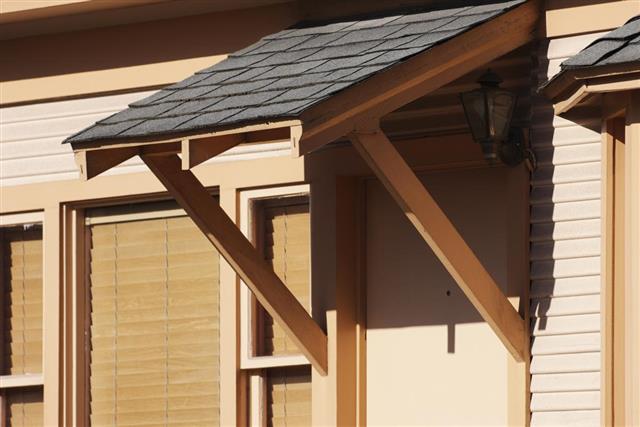
Wooden awning can be constructed successfully by following basic measurement and carpentry tips. For building a wooden awning in the patio, you will need wood posts, wood beams, nuts, screws, washers, bolts, and covering sheets.
Awnings are a type of canopy that can be constructed by attaching to the wall of the house, windows, doors, or as separate structures for the patio and deck. They can be used as outdoor furniture for enjoying and passing leisure time during the sunny or rainy months. Some of the benefits of having an awning are increased living space, sun protection, and energy efficiency. Based on your budget and personal preference, it can be made up of plastic, polyester fabric, metal, and wood.
One of the cost-effective and flexible awnings is a retractile type, which is set according to the weather conditions. It can be adjusted as per the requirements of the user. Another durable awning option is that of the wooden type. However, a concerning issue is that wood awnings for patios are quite expensive in comparison to other awning types. An alternative to reduce the construction cost is by building the patio cover on your own. If you have basic measurement and carpentry skills, you can accomplish building a wooden awning for your patio.
Instructions for Building a Wood Patio Awning
So, you have finally decided to construct a wooden awning in the patio? A simple approach that will simplify your project is to purchase do-it-yourself kits available in the local home improvement centers. You can opt for the one with lightweight and sturdy wood equipment. Such kits contain all the necessary hardware, wood materials, instruction booklets, and videos for successful building of a wooden awning. Prior to building the structure, you should go through the manufacturer guidelines carefully and try to understand the provided instructions.
Open and Check the Kit Contents
The supplies that you will find in the kit include wood posts and beams, wooden sheets for covering beams, corner brackets, knee braces, nuts, screws, washers, and bolts. Other tools required for building a wood awning are circular saw, reciprocating saw, stepladder, drilling machine, and safety gears. Once you are ready with all these required tools, you can begin with the steps for constructing a wooden awning.
Prepare the Posts and Beams
First of all, decide the height of the awning and cut the posts into equal lengths (as per the height) with the help of a circular saw. Work the ends of the wood to make them smooth. Following this, make a drill at one end on each of the posts for securing the bolts. Similarly, cut the wood pieces in order to prepare the overhead beams. Make equal length beams according to the dimension of the awning. Drill holes at the ends for fixing the poles.
Secure the Posts and Beams
The next step is to erect the posts at appropriate sites. Make sure that they are secured to the ground properly. Climb on the stepladder and put the seam to post corner brackets on the top of each posts. After the corner brackets are fastened tightly, introduce the wooden beams on the corner brackets. Screw the nuts and bolts in order to fix the beams with the corner brackets. For better security, affix knee braces on top of two adjacent support posts.
Give a Final Touch
Finally, lay the wooden covering sheets over the beams, making sure that they are equally distributed on the sides. Fasten them carefully with the beams by using appropriate sized nails. To get better results, you can nail or screw the sheets at regular intervals. Check for any ill-fitting fixtures and correct them (if necessary). This way, you can erect a wood patio awning on your own.
In order to add more aesthetic value to the patio cover that you have constructed, apply your creativity and implement some unique design ideas. Creating a canopy by growing climbers and other trailing plants is a good thought; you will get to enjoy greenery and clean air as well. As for increasing its durability, you are expected to adopt proper wooden awning maintenance tips such as scraping, refinishing or treating the wood once in a year to prevent pest infestations.




